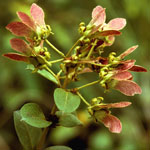
Stigmaphyllon retusum

Banisteriopsis wurdackii
Heteropterys alata

Hiraea longipilifera

Mascagnia schunkei

Tetrapterys
fimbripetala
fimbripetala

Dicella julianii

Echinopterys eglandulosa


Dispersal by water, birds, wind/water (plain cocci)
Dispersal by wind: wings and bristles
Among the many genera of vines, most of which probably share a common ancestor, the usual fruit is a dry schizocarp, with each mericarp a wind-dispersed samara. Two basic types of samaras have evolved, probably representing two aerodynamically optimal designs.
Samaras with a single dorsal wing (the maple type) are found in Banisteriopsis, Heteropterys, Stigmaphyllon, and other genera.
Samaras with a lateral wing, like that of elm, plus many variations, occur in Hiraea, Mascagnia, Tetrapterys, and many others. In a few genera (e.g., Dicella), the sepals grow into dry veiny wings as the fruit matures and presumably aid in dispersal.
In several genera the mericarps are bristly (e.g., Echinopterys), but those bristles do not seem to be adaptations for dispersal by animals; they are more likely to be variations on the wind-dispersal theme.